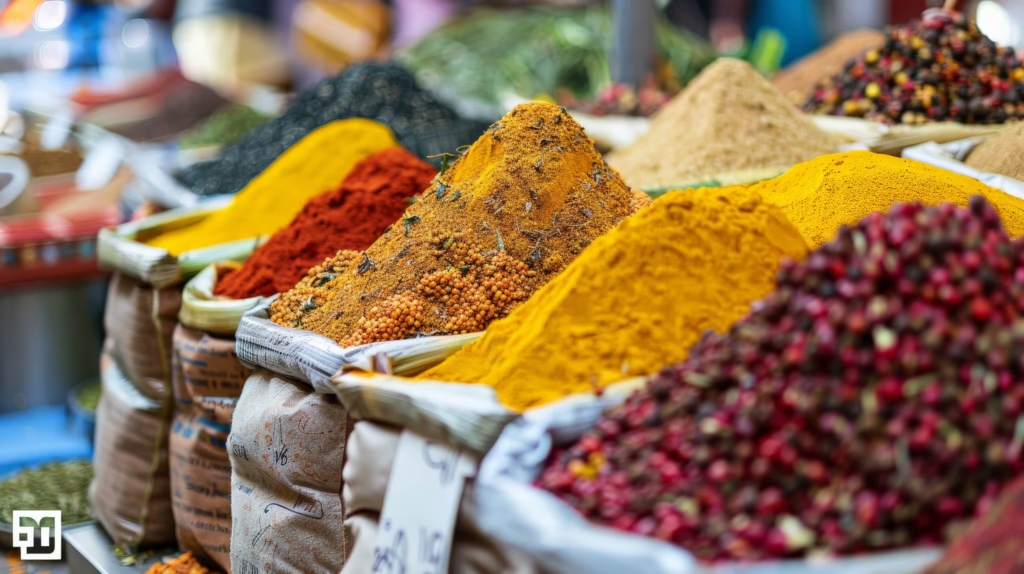Read Time: 4 mins

India is often referred to as the “Land of Spices,” and for good reason—it produces an astounding array of spices that have shaped global cuisines and trade for centuries. With a market value projected to exceed $30 billion by 2025, Indian spices are big business. They not only enhance flavors but also boast health benefits, making them a sought-after commodity worldwide.
For importers, small business owners, and culinary entrepreneurs, sourcing spices from India can be a game-changer. However, choosing the right spices requires careful planning and informed decision-making. This guide will walk you through the essential steps to ensure you import the best Indian spices for your business.
Understanding the Indian Spice Market
The Diverse World of Indian Spices
India produces over 75 different spices, accounting for roughly 75% of the global spice trade. From aromatic cardamom grown in Kerala to fiery red chilies from Andhra Pradesh, every region in India offers unique flavors. Here’s a snapshot of some key regions:
• Kerala – Renowned for cardamom, pepper, clove, and cinnamon.
• Rajasthan – Famous for cumin, coriander, and fennel seeds.
• Andhra Pradesh – Dominates red chili production.
• Gujarat – Known for mustard seeds and fenugreek.
Trends in Global Demand
The growing interest in Indian spices stems from their health benefits and versatility. Products like turmeric have garnered international acclaim for their anti-inflammatory properties, while spices like cumin and cinnamon are widely used in plant-based diets. Keeping an eye on global food trends—such as organic and clean-label products—will help you choose high-demand spices.
Identifying Popular Indian Spices for Import
High-Demand Indian Spices
Importing spices that appeal to global markets can boost your business. Here are some popular options:
• Turmeric – Valued for its vibrant color and medicinal properties.
• Cumin – A staple in Middle Eastern and Latin cuisines.
• Cardamom – Widely used in baked goods and beverages.
• Black Pepper – Known as the “King of Spices.”
• Coriander – A key ingredient in curry powders and masalas.
Factors Affecting Spice Popularity
1. Health Benefits – A growing focus on wellness has elevated demand for healthy spices like turmeric and ginger.
2. Culinary Trends – Spices integrated into modern cuisines (e.g., matcha turmeric lattes or cardamom desserts) are gaining traction.
3. Seasonal Availability – Some spices, like saffron and cardamom, are produced seasonally. Understanding harvest cycles can help you plan inventory.
Assessing the Quality of Indian Spices
Key Indicators of Quality
Quality assurance is critical when importing spices. Look for these attributes:
• Color – Vibrant hues often signify freshness.
• Aroma – Fresh spices have a distinct, strong fragrance.
• Texture – Uniform size, clean surfaces, and lack of debris are essential.
Organic and Non-GMO Certifications
To meet consumer demand for clean and sustainable products, prioritize suppliers offering organic, non-GMO certifications. This ensures your spices meet international quality standards and appeal to health-conscious buyers.
Grading Standards
India has strict grading standards for spices, which classify products based on cleanliness, size, and freshness. Familiarizing yourself with these grading systems can help you evaluate the quality of your purchases.
Finding Reliable Indian Spice Suppliers
Tips for Identifying Reputable Suppliers
A reliable supplier is key to successful importing. Here’s how to find one:
• Attend Indian trade fairs or exhibitions focused on agriculture or spices (e.g., Spices Board of India events).
• Use online directories like IndiaMART or globally recognized platforms like Alibaba.
• Seek referrals from trusted industry networks or associations.
Verifying Credentials
Always verify supplier certifications, such as ISO 9001, HACCP, or FSSAI. These guarantee compliance with international food safety and quality standards.
Building Relationships
Strong relationships with suppliers can lead to better pricing, consistent quality, and reduced risks. Regular communication and even site visits can cement these partnerships.
Navigating Import Regulations and Compliance
Overview of Import Regulations
Importing spices involves complex regulations. Key areas to focus on include:
• Phytosanitary Certification – Ensures products are free of pests or contamination.
• Food Safety Certifications – Comply with FDA or EFSA regulations, depending on your target market.
Required Documentation
Prepare for the following:
• Invoice and packing list.
• Certificate of origin.
• Import permit (if required).
Ensuring Compliance
Partnering with an experienced customs broker or consultant can help you meet all compliance requirements and avoid unnecessary delays.
Cost Considerations and Pricing Strategies
Calculating Import Costs
Take into account the following:
• Shipping – Freight charges depend on weight, volume, and destination.
• Tariffs – Check applicable duties for importing to your country.
• Storage and Packaging – Costs of protective packaging to maintain quality.
Negotiating Prices
Negotiating bulk orders and establishing long-term agreements with suppliers often yields better pricing. Don’t hesitate to shop around and compare quotes.
Balancing Cost and Quality
While cost is an important factor, compromising on quality can hurt your business in the long run. Strike a balance by prioritizing high-quality spices that justify their price point.
Logistics and Shipping Considerations
Selecting a Shipping Method
Choose between air freight for faster delivery or sea freight for cost efficiency. Spices that spoil less quickly, like dried seeds, are ideal for sea transport.
Maintaining Spice Quality
Proper packaging is crucial to preserve freshness during transit. Use vacuum-sealing or moisture-resistant bags to prevent contamination.
Solving Logistics Challenges
Enlist professionals for supply chain management to address potential hiccups like customs clearance delays or lost shipments.
Start Importing Indian Spices with Confidence
Importing Indian spices offers an incredible opportunity to add value to your business. By understanding the Indian spice market, sourcing high-quality products, and selecting reliable suppliers, you can build a profitable operation. Success lies in thorough research, compliance, and an unwavering commitment to quality.
Begin exploring premium Indian spices today, and transform your business offerings!
